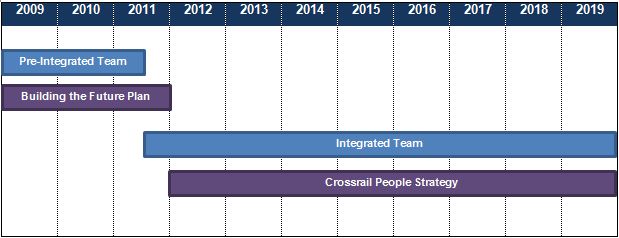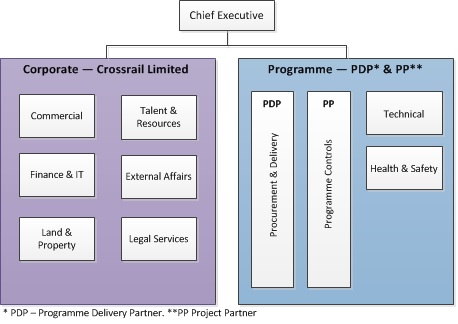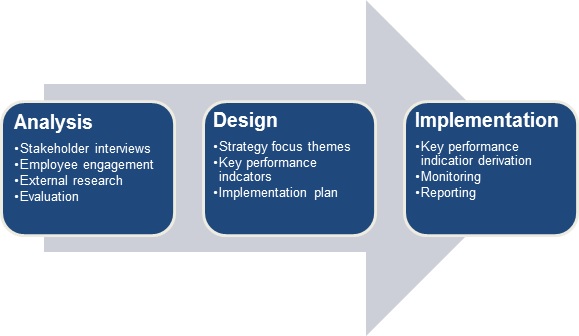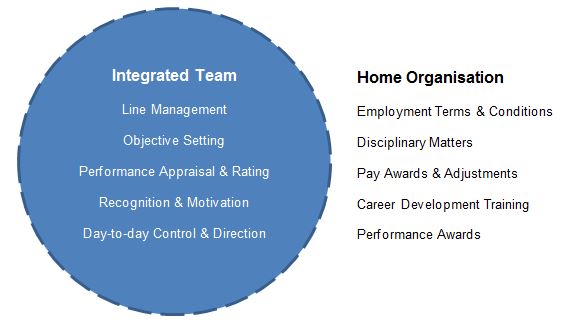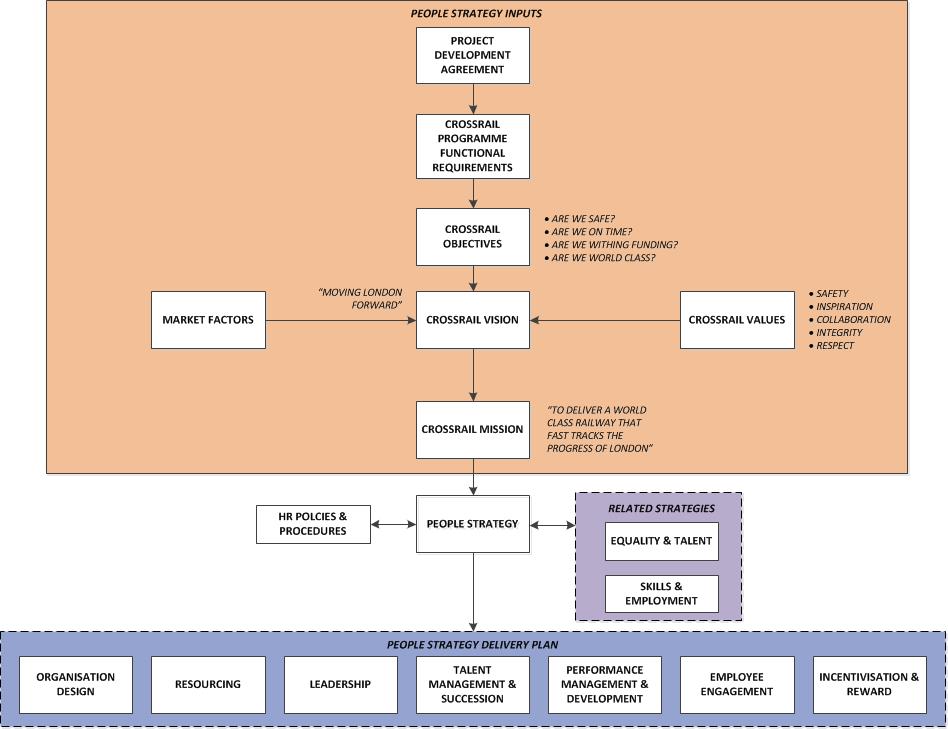
Crossrail People Strategy
Document
type: Case Study
Author:
Nathan Pascutto
Publication
Date: 27/09/2016
-
Abstract
Crossrail required the mobilisation of the right people to deliver the project on time and on budget. The People Strategy sets out Crossrail’s overarching approach to achieving a diverse workforce with the right people, at the right time, suitably skilled, motivated and engaged to deliver the Crossrail project. Informed by external research, stakeholder feedback and employee engagement survey findings, the People Strategy identifies five focus areas: safety culture; simplifying the organisation; sustaining the integrated organisation model; efficient and effective working; and workforce diversity.
The case study recommends that future projects developing a People Strategy consider:
- Benchmarking your people strategy against comparable projects
- Engaging with staff and providing regular opportunities for feedback, particularly with the senior leadership team
- Taking into economic, labour market and programme timing factors
- Aligning the strategy with your organisation’s objectives, vision, values and mission.
This case study will be of interest to: senior leadership teams; HR Directors; Organisational Development practitioners considering developing a People Strategy.
-
Read the full document
Introduction & Industry Context
Crossrail required the mobilisation of the right people to deliver the project safely, on time and within budget. Crossrail’s People Strategy set out Crossrail’s response to the people challenges on the project with the aim of creating a diverse workforce with the right people at the right time; who were engaged to deliver to the Crossrail project.
The Crossrail project is the biggest infrastructure project in Europe. It required the construction of 118 kilometres of new railway from Shenfield and Abbey Wood in the East to Heathrow Airport and Reading in the West, including the construction of 10 new stations.
The CIPD reports that since the 1990s businesses have placed a greater emphasis on managing human resources to support long-term business goals and outcomes with a strategic framework. This framework is generally in the form of a ‘People Strategy’ which focuses on longer-term people issues, future resource needs and organisational design, culture, values and development needs.
Crossrail’s People Strategy commenced with the Building the Future Organisational Development Plan in 2009. Following the implementation of the integrated team which brought together staff from Crossrail Limited, the Programme Delivery Partner and the Project Partner in 2011, Crossrail developed and implemented its People Strategy.
The Crossrail People Strategy provided one unified and aligned strategy for all of the people challenges across the project. It was informed by external research, stakeholder feedback and employee engagement survey findings.Crossrail’s Organisational Development
In 2009, Crossrail introduced its organisational development plan – Building the Future. This plan covered the period 2009 to 2012 and outlined where the Crossrail organisation needed to be in three years time to support the civil and tunnelling phase of the Crossrail project, and what people capacity and capability needed to be developed to get there.
Building the Future was focused on the mobilisation of the workforce and addressing those challenges during the initial stages of construction and delivery. When Building the Future was implemented, it was before the integrated team was formed. With the introduction of the integrated team in 2011, the organisational development plan was no longer fit for purpose and was replaced by the Crossrail People Strategy in 2012.
Figure 1 – Timeline of Crossrail Organisational Development Plan & People Strategy
Implementation of the Integrated Team
In 2011, the Executive and Investment Committee and the Crossrail Board made a decision to form the integrated team following feedback received in Crossrail’s employee engagement survey, the Big Dig. The Big Dig identified that Crossrail could do more to improve efficiency and performance by removing role duplication and improving decision making, collaboration and team work across the project.
Crossrail considered that these opportunities could be best addressed through the implementation of an integrated team model of where staff from Crossrail Limited, the Project Delivery Partner (PDP) – a joint venture of three organisations, and the Programme Partner (PP) – a joint venture of five organisations were brought together to operate as one single, aligned team.
Figure 2 – Organisation prior to implementation of the Integrated Team in 2011
Figure 3 – Organisation following the implementation of the Integrated Team in 2011
The integrated team model was considered to play to the strengths of both Crossrail Limited and the talent resourcing capability of the Partner organisations. It ensured that Crossrail, as an organisation, was always able to recruit the right person for any particular role across the project. Under the integrated team model, the Partners were responsible for supporting the project by resourcing the specialist and technical skills required across the entire integrated team. Generally the roles that the Partners would resource were specialised roles which Crossrail Limited did not have the capability or capacity to recruit to on its own.
The integrated team model was considered to encourage collaborative behaviours by helping to minimise internal contractual boundaries by encouraging staff from Crossrail Limited, the Project Delivery Partner and Programme Partner to operate as one team. It did this by introducing a common set of goals with a single set of managements system and procedures to align delivery.
“The introduction of the integrated team simplified accountabilities and created a framework for the collaborative tackling of challenges throughout the project, whilst ensuring Crossrail could recruit the best person for any particular role.”
Bill Tucker, Central Section Delivery, Project Delivery Partner“The integrated team brought together a high-quality team that can be adapted to suit the circumstances, supporting effective internal challenge, and reducing waste across internal contractual boundaries.”
John Pelton, Strategic Director, Programme PartnerDeveloping the People Strategy
The introduction of the integrated team model in 2011 meant that Building the Future needed to evolve into an integrated solution. Crossrail developed the Crossrail People Strategy which set out a single, unified vision and strategy of the integrated team’s approach to the people opportunities and challenges across the project. This included mobilising, developing, engaging, retaining and demobilising the workforce. The People Strategy was published in 2012 following approval from the Crossrail Executive and Investment Committee.
The People Strategy took around six months to develop and implement, including approval from the Crossrail Executive and Investment Committee. Key phases of the People Strategy’s development are outlined below.
Figure 4 – Development phases for the People Strategy
People Strategy Mission and Purpose
The People Strategy set out a clear mission:
“To maximise organisational potential by building high preforming teams and effective people practices to deliver every stage of the project”
With this mission in mind, the People Strategy set out to provide a framework for the different organisations to operate effectively, whilst still recognising that they were distinct and separate organisations.
Bringing together different organisations to effectively work together meant that there were challenges, particularly around team alignment, leadership, talent management and succession planning.
In response to these challenges, the People Strategy sought to encourage collaboration between the integrated team around common people issues rather than full integration. Further information on Crossrail’s approach to collaboration is outlined in the Collaboration at Crossrail case study.
Legal Framework
The formation of the integrated team brought together staff from multiple employers to operate as one team. In developing the People Strategy, it was important to consider wider employment law obligations to ensure that the existing employer-employee relationship remained clearly defined following integration. In line with this principle, it was decided that each employer’s employees would continue to operate under their own terms and conditions of employment. This approach avoided any lack of clarity or dilution of accountability regarding the identity of the employer-employee relationship. Where Crossrail-wide policies and procedures were required, these were agreed with partner organisations to ensure a consistent approach to implementation across the integrated team.
The diagram below shows elements which were within the scope of the integrated team, and those which remained the responsibility of the home organisation. It was important for Crossrail and it Partners to have an understanding of the boundaries of the employer-employee relationship.
Figure 5 – Elements of the Integrated Team
Early consideration of the legal framework was important for developing the integrated team. It ensured that Crossrail and its Partners were aware of aware of their legal obligations and parameters when determining the organisational design and ensured that Crossrail was best placed to manage risks during the organisational design progress.
Future projects should carefully consider the legal framework and map key accountabilities and obligations when they are considering organisational design.The Role of the Integrated HR Team in Strategy Development
The People Strategy was developed by the integrated Talent & Resources team which included human resources professionals from Crossrail Limited, the Programme Delivery Partner, and the Project Partner. It was important that all organisations were involved in the development and implementation of the People Strategy, as this would help to further imbed the integrated organisation and collaborative ways of working. In the case of the Partner organisations, it also provided them with an opportunity to help shape the People Strategy by bringing their experience, lessons learned and best practice from other major projects.
Informing the People Strategy
The People Strategy was shaped and informed by the needs of the Crossrail project. The requirements of the project were established by several elements which included:
- Project Delivery Agreement — a legal document which appointed Crossrail Limited the project delivery vehicle for the Crossrail project and set out the roles and responsibilities of Crossrail Limited; and the Secretary of State for Transport, Transport for London as joint sponsors.
- Crossrail Programme Functional Requirements — a document which outlines the requirements that Crossrail Limited, as the project delivery vehicle, must deliver as part of the Crossrail project.
- Market Factors — Current and forecast economic and labour market conditions which could affect the Crossrail project. This also included the lessons learned from other major projects and industry best practice.
- Crossrail’s Objectives, Vision, Values and Mission — these set out how Crossrail would function as an organisation to support project delivery and how its performance would be measured, including through employee engagement surveys
- Related Strategies — interventions which were outlined in other separate strategies which complemented and supported the people strategies objectives.
- HR Policies and Procedures — Crossrail’s operational HR policies and procedures which were implemented across the organisation.
Further information on the Project Delivery Agreement and the Crossrail Programme Functional Requirements can be found in the Learning Legacy paper on Structuring and Governance Arrangements.
The diagram below shows the relationship between the elements which informed the People Strategy (inputs), related strategies (inputs), HR policies and procedures, and the People Strategy themes (outputs). The elements in the diagram were outlined above.
Figure 6 – People Strategy Relationships
Identifying People Challenges & Priorities
The People Strategy underpins and drives Crossrail’s corporate objectives, vision, values and mission. Crossrail’s experience was that the vision, mission and values were particularly important as they clearly set out a positive statement of how Crossrail was going to deliver the project and ensured that there was a clear and aligned focus across the Crossrail organisation.
In determining the challenges and priorities for the People Strategy, the integrated Talent & Resources team undertook a desktop research exercise which considered:
- Best practice research from other relevant organisations/projects such as Heathrow Terminal 5,and the Olympic Delivery Authority
- Project Development Agreement, including undertakings from the Crossrail Act 2008
- Crossrail Sponsor Agreement with Department for Transport and Transport for London
- Outcomes from previous Crossrail organisation reviews
- Findings from the Big Dig employee engagement survey
In addition to the desktop research exercise, Crossrail also used internal stakeholder interviews which used a structured questionnaire to gain an understanding of key issues across the organisation. In conducting the interview, the Integrated Talent & Resources team made sure that there was representation across all levels of the organisation, to ensure that there was broad representation. The stakeholder interviews showed the following key issues for the integrated team:
- Organisation design
- Resourcing
- Leadership
- Talent & succession management
- Performance & management
- Employee engagement
- Incentivisation and reward
- Joint working / integration with partners
The desktop research on other large projects such as Heathrow Terminal 5 and the Olympic Delivery Authority proved to be extremely informative in helping Crossrail to determine its people strategy priorities. The research highlighted many of the workforce challenges associated with finite infrastructure projects, and showed that many of the organisations successfully faced and managed similar workforce challenges.
Challenge Learning for Crossrail Leadership alignment Build consensus at leadership level and communicate clearly with the workforce Permanent staffing vs contingent workforce Consider phasing workforce interventions to ensure the right focus at the right time Equality & diversity Equality & diversity ensure that people policies and practices promote diversity Role of the lead organisation Carefully consider the role which it plays at each stage of the project Communication Building integrated internal and external communication plans Figure 7 – Key learnings from the desktop research exercise
Taking into account the elements which informed the People Strategy, outlined in the earlier section above, and the issues identified through research, it was considered that the People Strategy should focus on five key priority areas:
- Driving our safety culture
- Simplifying our organisation and how we work
- Building on and sustaining our integrated organisational model and promoting joint working where it makes good business sense
- Maintaining our focus on effective and efficient working and managing workforce-related costs
- Building a diverse workforce
In determining how to respond to the five people priorities which were considered during the development of the People Strategy, the integrated Talent & Resources Team identified seven key themes. The seven key themes that were identified spanned the employee lifecycle from joining to leaving the project. Each of the seven themes outlined a clear goal and objective, with further information available in the linked learning legacy documents.
Theme Goal Organisation Design Organisational structures are the right size and shape with the required skills composition to meet the needs of the programme both functionally and financially Resourcing High calibre individuals are attracted to Crossrail and their skills and experiences are used efficiently and effectively Leadership The workforce is inspired and motivated by their leaders Talent Management & Succession Planning The experience and individual development gaining by working on Crossrail will broaden future job opportunities once their role within the organisation has come to an end Performance Management & Development Individuals and teams have the opportunity to develop further and deliver world class performance Incentivisation & Reward Employees are rewarded fairly and recognised for high performance in both financial and non-financial terms Equality & Diversity Not directly addressed in the People Strategy. Refer to separate Equality & Talent Strategy Skills & Employment Strategy Not directly addressed in the People Strategy. Refer to separate Crossrail Skills & Employment Strategy Figure 8 – Crossrail People Strategy
In response to each of the seven key themes and goals, measures of success were identified and were included in the People Strategy. The measures of success which were use to assess performance against each theme are outlined in pages 18-20 of the Crossrail People Strategy, and have been included in the Reporting Progress section of this paper.
The key themes, goals and measures of success were used to complete People Strategy action plans which were considered by the Executive and Investment Committee. The action plans were reviewed periodically in response to feedback received through Crossrail’s employee engagement survey, the Big Dig. Further information is included in the Senior Leadership Support section below.
Equality & Diversity
Crossrail had a unique opportunity to improve equality and diversity across the industry. With this opportunity, Crossrail considered that it would be more effective to set out its objectives and targeted interventions for equality and diversity in a separate strategy — Equality & Talent, rather than including them as part of the People Strategy. In line with this principle, the People Strategy was designed to complement and support the Equality & Talent Strategy, and assist in the Equality & Talent Strategy’s implementation. Further information on is outlined in the Equality & Diversity Strategy case study.
Crossrail Skills & Employment Strategy
Crossrail supported over 55,000 jobs during construction, providing an opportunity for a strong skills and employment legacy. The Crossrail Skills and Employment Strategy was published in 2010, prior to the implementation of the integrated team and the People Strategy. As many of the recommendation of the Skills and Employment Strategy were already being implemented, Skills and Employment outcomes were not considered in detail in the People Strategy. The People Strategy, however, supported the Skills and Employment Strategy’s continued implementation across the organisation. Further information on the Skills & Employment Strategy micro-report.
Senior Leadership Support
Key to Crossrail’s success in implementing the People Strategy was highly visible support from the Chief Executive and the Executive & Investment Committee. This was important in raising the profile of the People Strategy and providing visibility that the Strategy was supported by the leadership team. Crossrail’s leadership team used a variety of channels to engage with the workforce both within Crossrail’s head office and on Crossrail sites including:
- Tool box talks — talks/presentations of 15 minutes on a specific subject from senior staff
- All hands briefings – ‘big picture’ updates hosted by a member of the Executive & Investment Committee, including robust questions & answers, local awards presentations and a social event.
- Programme Leadership Team roadshow – an annual series of events to engage the Delivery team about key priorities
- Leadership briefings – a four-weekly update on the progress of the project and focus for the period ahead.
The People Strategy and action plan was considered and approved by the Executive & Investment Committee who had the overall accountability for driving the Crossrail project forward. The Talent & Resources Director was accountable for the overall delivery of the People Strategy across the integrated team and wider project, and regularly reported progress of the Strategy’s implementation to the Executive & Investment Committee and the Crossrail Board.
Other Directors were responsible for leading the implementation of the People Strategy and the action plan locally within their directorate, with support from Talent & Resources. Providing teams with the support mechanisms to implement the People Strategy such as access to internal organisational effectiveness and employee engagement specialists resulted in there being a high level of ownership and engagement within teams at a local level. The buy-in and visible support from the senior leadership team was also an important catalyst for driving up performance and influencing behaviours.
Communicating & Implementing the Strategy
Successfully communicating and implementing the People Strategy was key to the Strategy’s success.
The People Strategy outlined a commitment to engage with the integrated team and provide regular updates on the implementation of the Strategy and any related issues as part of Crossrail’s on-going employee engagement plans.
The communication and employee engagement process was led by the Internal Communications Team within the Organisational Effectiveness Department, in Talent & Resources. Having the Internal Communications Team within Organisational Effectiveness proved effective as it ensured close alignment and collaboration with the Organisational Effectiveness Advisors who supported teams to implement the People Strategy.
Further information on Crossrail approach to employee engagement is outlined in the Employee Engagement micro-report.
Reporting Progress
Crossrail regularly measured its progress against the People Strategy to ensure that implementation was on track. Progress was measured and reported in two distinct ways — through regular periodic measurement and reporting to the Executive & Investment Committee and the Crossrail Board and through less frequent employee surveys.
Periodic Reporting
Periodic reporting occurred every four weeks, in line with Crossrail’s corporate reporting calendar. The information was measured and reported in the Crossrail Programme Report which was considered by both the Executive & Investment Committee and the Crossrail Board. In addition to the Programme Report, the integrated team also prepared progress reports for the Sustainability Committee, the Remuneration Committee, the Risk Sub-Committee and the Integrated Resourcing Group.
Figure 9 outlines the key metrics and outputs for each of the seven People Strategy themes. Workforce diversity data (women, BAME, Under 25 and Disability) was also reported as part of the Programme report to the Executive & Investment Committee and the Crossrail Board, as well as the Sustainability Committee. The diversity metrics, however, are not included below as they are outlined in Crossrail’s equality and diversity strategy, Equality & Talent.
Theme Metric Organisational Design - Cost of support function
- Benchmarks
- Total workforce cost
- Number of joint working initiatives
- Design principles consistently applied
- Reduced duplication between Partners
- Organisational composition
Resourcing - Cost per hire
- Time to hire
- Staff turnover
- Leaver analysis
- Agency spend
- Partner premiums
Leadership - Leadership team retention
- Big Dig scores relating to Leadership
Talent Management & Succession Planning - % voluntary leavers from talent /succession pool
- Number of ‘ready for role’
- successors
- Time to fill key roles
- Number of internal promotions
Performance Management & Development - % of individual objectives achieved
- Achievement of corporate objectives
- Learning & development outputs
Employee Engagement - Big Dig scores
- Voluntary leaver rates
- Short term unplanned absence rates
Incentivisation & Reward - Total workforce spend
- Market positioning of salaries for key roles
- Voluntary leaver feedback Crossrail pay and reward
- Big Dig results
Figure 9 – People Strategy Reporting Outputs & Metrics
Employee Surveys
In addition to periodic reporting, Crossrail also measured its progress through employee an employee survey, the Big Dig, which was conducted at regular intervals every 12-18 months between 2011 and 2015. The Big Dig provided staff from the integrated team with the opportunity to provide anonymous qualitative and quantitative feedback on their experiences at Crossrail via an independent external research company. This proved to be useful in supplementing the information which was reported on a periodic basis from the integrated team.
The data was aggregated at directorate and function level identifying opportunities for improvement. Teams developed their own Big Dig action plans with support from Crossrail’s Organisational Effectiveness team to address issues which were identified from the survey. Accountability for implementing these plans rested with the accountable director and their leadership team.
The Big Dig received a response rate of between 81% and 93% for the four surveys completed since 2011, providing a strong indication on the views of the integrated team. Data collected over the four surveys concludes that strong progress was made against the People Strategy, between 2011 and 2015, as outlined below
Figure 10 – Key Big Dig employee engagement survey data — 2011-2015 Note: No survey was held in 2014.
In 2015 the Crossrail Board decided that Crossrail would undertake no further Big Dig surveys given that the culture of the programme was firmly embedded within the integrated team. It was considered that it was more responsive for the Organisational Effectiveness team to work with individual teams locally to respond to challenges when they occurred rather than relying on the outcome of a programme-wide survey.
External Accreditation
Crossrail received Investors in People Silver accreditation in 2013. The Investors in People accreditation is considered the benchmark of good people practice. It consists of nine indicators which are set out under the three criteria of leading, supporting, and improving. Over 14,000 organisations have received Investors in People accreditation. Crossrail’s Silver accreditation placed Crossrail in the top 13% of accredited organisations worldwide. Investors in People accreditation is valid for three years from the date of accreditation.
Conclusion / Lessons Learned
- The Crossrail People Strategy has been effective in addressing the people challenges across the project. As a major project, Crossrail considered that the People Strategy was important in aligning the integrated team at the time of its implementation and embedding a positive culture and behaviour throughout the lifecycle of the project.
- Crossrail considered that it was important to make sure that the People Strategy took into account a range of views and this is why Crossrail undertook a wide range of research both internally and externally with comparable major projects. External benchmarking with comparable projects proved beneficial as it provided an insight to how other projects approached similar issues and their lessons learned. Both the internal and external research showed that there were many common issues/challenge identified across the research cohorts.
- Crossrail found that regular engagement with the integrated team was crucial for measuring progress and driving performance. In addition to regular feedback opportunities, Crossrail considered the regular employee engagement surveys were extremely effective as they provided good benchmarking and provided an indication of longer-term trends.
- Future projects should consider implementing a People Strategy as it ensures that organisations are best placed to address people challenges, and ensures that there is a strategic framework in place to address the organisation’s resourcing, organisational design, culture values and development needs.
Recommendations for Future Projects
- Benchmark your people strategy against comparable projects to ensure that your strategy takes into account best practice to respond people challenges. Major projects can have similar challenges and issues, meaning that there is key learning that can be embedded from other projects.
- Take time to engage with your staff and offer staff regular opportunities to provide feedback. Feedback from staff is important for assessing the effectiveness of your strategy’s implementation. Offer staff the opportunity provide feedback both informally and at regular intervals through employee engagement surveys – at a minimum two yearly intervals. Employee engagement surveys are a good way to check-in and benchmark progress.
- Take into account economic, labour market and programme timing factors and amend your People Strategy as necessary to respond to changing circumstances. These factors will influence how effectively an organisation will be able to attract and retain talent and how effective the organisation can transition through the lifecycle of the project.
- Align your people strategy with your organisation’s objectives, vision, values and mission. This will ensure that there are consistent themes and messaging across the organisation and will ensure that policies and procedures are in line with the People Strategy
- Leadership engagement is critical for establishing effective cultures and behaviours that support the people strategy. Ensure that your leadership team engages with the People Strategy. The leadership team needs to be visible and take ownership in implementing the strategy at a local level.
-
Document Links
-
Authors
Nathan Pascutto
Nathan Pascutto was the Business and Policy Manager for Talent & Resources at Crossrail from 2014 until 2018. Prior to joining the Crossrail project, Nathan held senior policy positions across both the Australian and UK Governments, including the Department of Finance, and the Treasury in Australia; and the Department for Education; and the Department for Energy and Climate Change in the UK.
Nathan has a Bachelor of Business and a Bachelor of Laws from Southern Cross University, Australia, and a Graduate Diploma of Legal Practice from the Australian National University.
-
Peer Reviewers
Peter Gregory, High Speed 2 Ltd
Warren Howlett, Head of HR Content, CIPD
Michael Leicht, e.on
